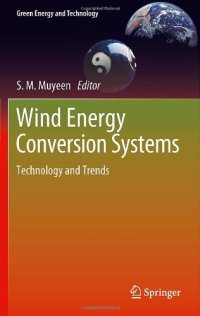
Ebook: Wind Energy Conversion Systems: Technology and Trends
- Tags: Renewable and Green Energy, Renewable and Green Energy, Control, Sustainable Development
- Series: Green Energy and Technology
- Year: 2012
- Publisher: Springer-Verlag London
- Edition: 1
- Language: English
- pdf
Wind Energy Conversion System covers the technological progress of wind energy conversion systems, along with potential future trends. It includes recently developed wind energy conversion systems such as multi-converter operation of variable-speed wind generators, lightning protection schemes, voltage flicker mitigation and prediction schemes for advanced control of wind generators.
Modeling and control strategies of variable speed wind generators are discussed, together with the frequency converter topologies suitable for grid integration. Wind Energy Conversion System also describes offshore farm technologies including multi-terminal topology and space-based wind observation schemes, as well as both AC and DC based wind farm topologies. The stability and reliability of wind farms are discussed, and grid integration issues are examined in the context of the most recent industry guidelines. Wind power smoothing, one of the big challenges for transmission system operators, is a particular focus. Fault ride through and frequency fluctuation mitigation using energy storage options are also covered. Efficiency analyses are presented for different types of commercially available wind turbine generator systems, large scale wind generators using superconducting material, and the integration of offshore wind and marine current farms.
Each chapter is written by a leader in the wind energy arena, making Wind Energy Conversion System a valuable reference for researchers and students of wind energy.
Wind Energy Conversion System covers the technological progress of wind energy conversion systems, along with potential future trends. It includes recently developed wind energy conversion systems such as multi-converter operation of variable-speed wind generators, lightning protection schemes, voltage flicker mitigation and prediction schemes for advanced control of wind generators. Modeling and control strategies of variable speed wind generators are discussed, together with the frequency converter topologies suitable for grid integration. Wind Energy Conversion System also describes offshore farm technologies including multi-terminal topology and space-based wind observation schemes, as well as both AC and DC based wind farm topologies. The stability and reliability of wind farms are discussed, and grid integration issues are examined in the context of the most recent industry guidelines. Wind power smoothing, one of the big challenges for transmission system operators, is a particular focus. Fault ride through and frequency fluctuation mitigation using energy storage options are also covered. Efficiency analyses are presented for different types of commercially available wind turbine generator systems, large scale wind generators using superconducting material, and the integration of offshore wind and marine current farms. Each chapter is written by a leader in the wind energy arena, making Wind Energy Conversion System a valuable reference for researchers and students of wind energy.